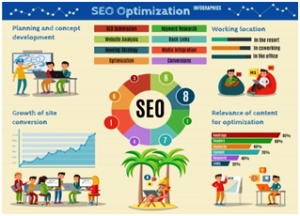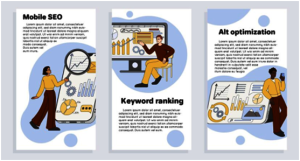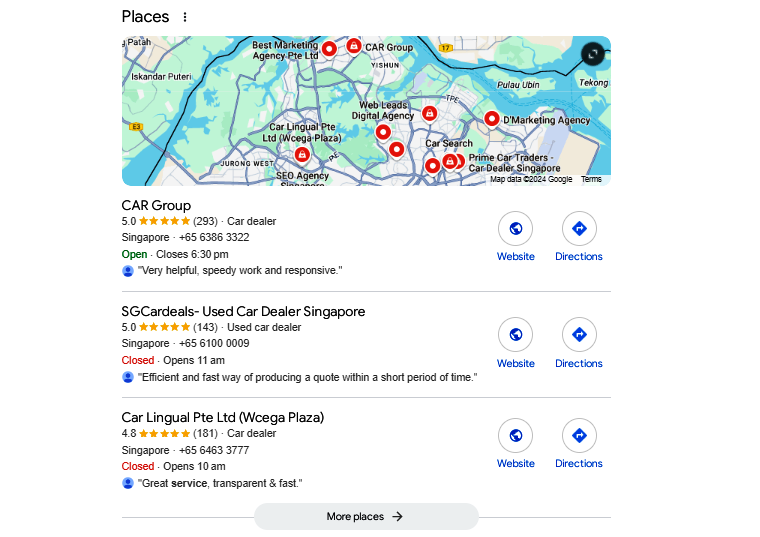One significant challenge for car dealerships in Singapore today is catching the eye of the smart online car shopper and then converting this attention into actual showroom visits. Car dealership SEO is just what businesses need to deal with this challenge.
According to Statista, global spending on digital services is forecast to reach 3.9 trillion U.S. dollars by 2027. global spending on digital services was projected to grow from $1.31 trillion in 2020 to $2.49 trillion in 2024.
This shift highlights the growing expectations of consumers who want seamless and personalized experiences. It is important to stand out and accurately target buyers at the right moment in the buyer journey. As such, car dealerships must focus on enhancing their SEO capabilities to meet these rising demands in Singapore.
The stakes are very high now. Car dealership SEO has emerged as the way to maintain visibility and credibility among hundreds of others vying for buyers’ attention. Strategically optimizing the car dealership website’s visibility on search results means capturing more clicks and, more importantly, qualified leads at all stages of the car-buying journey, from initial research to final decision-making.
This article will highlight current SEO strategies for Singaporean car dealerships, providing practical insights into building an online presence to engage potential buyers and consistently drive high-quality traffic to your dealership’s virtual and physical doors. Whether it be a boost in local SEO to enhance user experience or an opportunity to get video content and drive sales, this article breaks it all down.
Why SEO Matters for Singaporean Car Dealerships?
The automotive market is predicted to grow by 1.49% annually from 2024 to 2029, with 941 enterprises by 2024. The competition is real. But it is easier to stand out if you take a more strategic approach. (Source: Statista)
Search engine optimization is integral to ranking and building trust within Singapore’s competitive digital landscape.
With 95 % of car buyers initiating research online, a solid SEO content strategy will ensure that your dealership appears in the initial searches. (Source: Google Research)

Here are some poignant factors to consider:
1. Building Visibility and Trust
Ranking well within search results can build trust and connect your dealership with buyers actively searching for a specific vehicle or dealership. A high ranking signals reliability and increases clicks, visits, and showroom foot traffic. This visibility bolsters your reputation and credibility—the gateway to trust conversion for these Singaporean consumers.
2. Local SEO: Capturing Nearby Customers
It helps increase your business’s visibility to customers near you who are actively looking for a product or service. Optimizing Google Maps and Google business profiles can generate more direct calls, leads, and sales. A website with location-based keywords attracts targeted traffic, allowing you to reach qualified, ready-to-engage customers.
For instance, Singapore’s automotive industry employs over 50,000 workers, who make about $72,100 worth of productivity. (Source: Statista) Hence, local SEO can help car dealerships find clients nearby in such a competitive business environment. By optimizing their Google Business Profile, using location-specific keywords, and managing reviews properly, they will outshine their competition in the local search for a specific model or service.
In a crowded market, local SEO thus becomes a strategic advantage, allowing businesses to capture ready-to-buy customers and position themselves as the top choice in the area.
3. Cost-Effective Lead Generation with High ROI
With a high value-added margin of 32%, the automotive market in Singapore showcases that car dealership SEO is a very ROI-based cost-effective strategy for dealerships. (Source: Statista)
Unlike conventional advertising, SEO produces quality leads from actively interested buyers. Unlike traditional advertising, it does not require significant ongoing investment; instead, it builds organic traffic over time, enhancing short-term sales and long-term loyalty through steady engagement.
Note: According to a 2023 McKinsey report, Generative AI may boost global productivity by a staggering $4.4 trillion per year. So, car dealerships can use AI to instantly create high-quality content like blogs, ads, or localized campaigns. It supports publishing engaging SEO content at a fraction of traditional costs, maximizing marketing ROI.
4. Sustainable Market Positioning
SEO is adaptable to search algorithms. Continuous updates in content, site structure, and mobile optimization keep your dealership relevant and maintain a robust digital presence and competitive edge.
The bottom line is that if car dealerships are to survive in Singapore, they will need SEO. Local SEO, an improved user experience, and multimedia engagement are the top players in this digital-first auto market.
5. Data-Driven Insights for Enhanced Engagement
Technologies like Generative AI empower car dealership SEO efforts to offer valuable insights into customer preferences, enabling your dealership to tailor content to local demand. This data-driven approach enhances the customer experience, fostering loyalty and positioning your dealership as a trusted information source for Singaporean consumers.
For example, car dealerships create digital experiences by using AI and analyzing popular queries on models, features, or financing. They produce customized video shows using customer data to improve content alignment with audience interests. These shows highlight specific models or colors that resonate with each customer’s preferences.
6. Enhancing User Experience for Higher Conversions
A seamless user experience (UX) is at the heart of successful SEO. Intuitive, engaging, and easy-to-navigate sites keep visitors on your page longer and signal relevance and quality for search engines, boosting search rankings and garnering customer trust and the likelihood of conversion.
Features such as fast loading times, mobile responsiveness, and clear calls to action make it easier to find the process from scheduling a test drive to submitting an inquiry or viewing vehicle details. Properly optimized user experience does not simply attract but very gently leads customers towards some further action. In short, it increases lead generation, sales, and customer satisfaction.
7. Video SEO for Broader Reach
Video content SEO is so effective for automotive marketing that 40% of shoppers visit a car dealership after watching a video, and ‘test drive’ video watch times have increased by 65% in the last year. It gives car dealerships an opportunity to catch early interest by making it visible through titles, descriptions, and tags. All these high-quality videos around models, customer testimonials, or maintenance tips make your viewers engage and buy. (Source: Think With Google)
Generative AI can also be a significant factor in video marketing. It opens new roads to deepening customer connections with the application of AI. With more differentiated solution offerings to customers, it delivers better results and satisfaction than less technologically empowered competitors.
Car dealerships can offer customers the ability to design custom electronic invitations or experience virtual representations of showrooms. Virgin Voyages did this through AI-powered customizable invitations, which had quite a desirable effect on sharing.
Matching Search Intent with Car Dealership SEO in Singapore
Owning a car in Singapore is a significant investment. Understanding search intent is important for implementing effective car dealership SEO strategies. All types of intent depict where the buyer is and, thereby, help car dealerships craft appropriate content, attract and engage users, and eventually convert them into paying customers.
Here’s how these goals may impact SEO in car dealerships:

Buyer’s Journey: The Path to Purchase
Generally, car buyers undergo the following stages.
- Research: Asking initiating exploratory questions to gather information.
- Consideration: Searching for options with supermarket searches.
- Decision: Fulfill Sales through Transactional Search.
Map customer journeys to identify everything that touches an interaction from the beginning to where a car buyer engages during purchase, then line up these stages to better engage and to more closely convert customers. Identify the time and place of SEO search that targets the right intent.
Understanding this process helps dealers create targeted content for each type of activity, improving a car dealership website’s SEO performance.
Guide Car Buyers in Singapore: From Research to Purchase
It is important to engage car buyers at every stage by tailoring content to their intent, from initial research to ready-to-buy actions. This approach builds brand trust, supports informed choices, and drives conversions.
1. Informational Intent: Awareness Generation
A buyer from Singapore would begin by conducting general research, including facts regarding brands, models, fuel efficiency, and even the Certificate of Entitlement prices. The keywords would be “best fuel-efficient cars in Singapore” or “COE prices for SUVs.” Such searches are typically practice-oriented.
Write guides, blogs, and comparison articles on popular searches to build expertise and talk to your potential buyer. Add an infographic or video showing COE trends or car features to break up the information beautifully and visually.
2. Commercial Intent: Supporting Informed Choices
Buyers with commercial intent narrow the choices with queries such as “Honda Civic vs. Toyota Corolla comparison.” Maintenance cost, resale value, and different features are relevant during the final decision-making step, which is most conducive to this stage.
Publish targeted comparison content with customer testimonials or video reviews to add depth. This helps potential customers see practical applications and resonate more with your brand.
3. Transactional Intent: Capturing Ready-to-Buy Customers
Ready-to-buy customers usually look for specific models, dealers, or services, like “buy Mazda 3 Singapore.” These customers have decided to finalize the purchase or schedule a test drive.
An optimized product page with the right keywords, clear calls-to-action, and easy access to booking forms is a requirement. A Google Business Profile with “Book a Test Drive” options will always enhance visibility in local search, thereby bringing more instant leads.
4. Navigational intent: Driving brand-aware searches
Navigational searches are “ABC Motors Singapore,” which show people know your brand and are trying to reconnect or find information. Optimize branded keywords. The home page and contact info can also be easily accessed. Trust is built by keeping the branding consistent on-site and on social media, and it comes back when a customer is ready to purchase.
Local Intent: Location-Based Query ‘Capturing
Local queries play a very significant role beyond understanding general search intent. For instance, keywords like “best car dealership in Singapore” reflect the need to target location-based searches.
Use tools like Google Keyword Planner or Ahrefs to find local keywords and use them within your content. Optimizing the Google Business Profile with proper local information can significantly help improve visibility and drive foot traffic into your dealership.
With car dealership SEO aligned at every stage of buyer intent, businesses in Singapore can guide a prospect through the entire process from research to purchase. Your dealership will capture more leads and establish long-term customer relationships through intent-optimized content, further propelling growth in Singapore’s competitive automotive market.
Step-By-Step Guide to Crafting Effective Keyword Strategy
Effective SEO content aligns keywords with user intent to address what customers are actively searching for. This approach boosts visibility and drives relevant traffic by targeting terms with high search volume and relevance.
Optimal keywords drive traffic and serve ready-to-buy customers by increasing bookings for test rides and services. However, keyword optimization needs to pick popular phrases. Your car dealership SEO plan must resonate with customer intent, local relevance, and your dealership’s inventory. It should also be seasonal and trend-driven for the highest relevance.
1) Understand Customer Search Intent at Every Stage
Customers use different keywords depending on where they are in the sales funnel. An effective strategy has to focus on all phases of intent so the content can reach the users’ needs and push them to conversion.
Top of the Funnel Awareness & Discovery
Keywords similar to the ones below attract early-stage researchers:
- Best Family SUVs 2024
- Electric cars under $30k
Middle of the Funnel (MOFU): Compare & Consider
Keywords that attract clients when choosing:
- Toyota RAV4 vs Honda CR-V
- Certified preowned SUVs under 15K
Bottom of the Funnel (BOFU): Purchase Intent
High-converting keywords with transactional intent are:
- Rent a Toyota Camry near me.
- Book a test drive [Model] at [City]
By applying intent-based keywords in all your content, you’ll attract the right customers throughout every buying cycle and convert them with minimum hassle.
2) Usage of local keywords for geo-targeting
Local SEO is critical for car dealerships since most customers find a car and services in their localities. Google favors location-based results, so your keyword strategy must include a combination of primary and long-tail local keywords to gain maximum visibility.
Primary Local Keywords may be:
- Ford dealerships in [City]
- The Chevrolet service center near my location
Long-Tail Local Keywords may include:
- Used Cars in [City]-Low Mileage Used Cars.
- Lease deals on Jeep Grand Cherokee in [city/state]
Ensure your Google Business Profile is optimized with local keywords, detailed service descriptions, and review responses. This will increase the chances of appearing in Google Maps and local search results.
3) Target Primary, Brand, Model, and Inventory-Specific Keywords
Many customers know what brands or models they want. Optimization for main keywords like car models, brands, and services and branded and model-specific terms ensures that the content matches high-conversion queries.
Primary Keywords for some of the top models and services include:
- Toyota Camry lease deals in Singapore
- Cheap Used Cars Singapore
Brand-level keywords may be similar to:
- The Mazda dealership near me
- Best Ford trucks in my town
Model-specific keywords may include:
- Rent a 2024 Toyota Camry in [City]
- Used Jeep Wrangler Unlimited For Sale
Inventory status keywords can be similar to:
- Nissan Altima [city in-stock]
- Certified pre-owned SUVs for under 10k
Use keyword mapping to apply these keywords to specific web pages, such as model pages for new vehicles, comparison blog posts, and service pages for maintenance. This would help visitors find the desired content quickly, reducing the bounce rate. These keywords must be updated frequently for inventory changes and seasonal changes.
4) Use Service & Parts Keywords for Repeat Business
Service and maintenance keywords are valuable for driving recurring business, especially during off-peak sales. Use them to ensure your service department stays busy year-round.
Service Keywords:
- Brake Repair near [City]
- Oil change service in [City]
Parts Keywords:
- Order authentic Honda parts [City]
- Toyota accessories are purchased online
Adding structured data to service pages, like the FAQ schema, would help earn rich snippets, increase click-through rates, and make the dealership look more authoritative in services.
5) Use Right Keyword Research Tools
Keyword research tools like Google Keyword Planner, SEMrush, and Ahrefs help with search volume and competition information to identify high-intent, low-competition keywords. Competitive analysis can determine what works for others, which means there may be keyword gaps.
Key questions to ask may include:
- What is the competitor ranking locally?
- Is there a niche that should be discussed more, such as electric cars?
- How can I distinguish by using hyper-specific long-tail keywords?
Monitoring industry trends like EVs or holiday promotions means your strategy will change and stay current.
Keyword Optimization with Intent-Based Targeting
Key is an essential constituent in search engine optimization. Natural content integration or keyword integration ensures relevance and enhances user experience.
- Page Titles & Meta Descriptions: Signal relevance with high click-through rate.
- Headings: Use H1, H2, H3 to organize content logically and boost SEO.
- URLs & Alt Tags: Enhance on-page SEO and accessibility.
- Calls to Action (CTAs): Use conversion-focused phrases like “Schedule a Test Drive” or “Check Inventory.”
Content must answer all common customer questions. Here are some examples:
- What are some excellent lease deals this month?
- How to Finance a Used Car in [City]?
Avoid keyword stuffing. Instead, focus on practical, well-organized content that aligns with the searcher’s intent and improves site usability.
6) Monitor, measure, and adapt your keyword strategy
SEO is not a static process. Google Search Console and other analytics tools help you track the performance of your keywords. You can adjust according to accurate data.
Key metrics to track: Keyword rankings and Organic traffic Conversions from high-intent pages Target landing page bounce rates Identify low-performing keywords and upgrade to trending models or services. This means continuous optimization of your dealership for visibility, competitiveness, and responsiveness to changes in the market.
A successful keyword strategy for car dealerships does more than improve rankings—it drives relevant traffic that converts into leads, sales, and service appointments.
With the right approach to intent-driven keywords, local SEO, and content alignment with inventory, your car dealership SEO initiatives will attract clicks, build lasting customer relationships, fill test-drive schedules, and generate recurring service revenue.
Local SEO for Car Dealerships in Singapore
Local SEO is what most automotive business companies in Singapore rely heavily on significantly. More and more now, people using search engines to find car dealers and mechanics mean a strong position in search engine local listings crucially influences revenues; hence here are the techniques to catch:
1. Optimize the Google Business Profile
Optimized GBP will make any automotive-related business visible on local search results and Google Maps.
- Claim and Verification: Claim and verify your GBP to strengthen your credibility.
- Full Record: Verify the business name, address, telephone number, and hours. List primary and secondary categories, such as “Car Dealer” and “Used Car Dealer.”
- Q&A Section: Answer questions like “What financing options are available?” to boost keyword relevance.
- Regular Update: Keep the profile updated by posting frequent updates about new inventory or promotions.
- Quality Images: Good pictures of your showroom and the staff increase familiarity and involvement of the customer.
2. Optimize for Local Keywords
Targeting local keywords will help to reach nearby customers.
- Location-Based Keywords: “Used car buying in Singapore” and “Leasing a car in Singapore.”
- Location Pages: You should have location pages if your business has multiple locations. Use the following types of phrasing: “Orchard car repairs” or “Jurong used car dealership.”
- Singapore-Specific Terms: Incorporate local slang like “COE” (Certificate of Entitlement) to resonate with Singaporean buyers.
3. Local citation building and NAP consistency
Citations in local directories with consistent Name, Address, and Phone (NAP) data amplify visibility and rankings.
- Singapore-based Directories: Ensure your company is listed in Singapore’s SGCarmart, Carousell, and Autobacs directories.
- Automotive Directories: Appear in industry-specific directories to increase visibility and credibility among car buyers.
4. Generate and Manage Reviews
Reviews affect the ranking and customers’ loyalty.
- Encourage Reviews: Make customers happy by reviewing Google and any other site like SGCarmart.
- Respond to Reviews: Deal with all reviews immediately. Doing so lets customers know their opinions matter.
- Highlight Positive Reviews: Share customer testimonials on social media to encourage further engagement.
5. Adopting Local Content Marketing Approach

It markets your business as a head in Singapore’s auto car market.
- Address Local Concerns: Create content on topics like COE trends or insurance requirements relevant to Singaporeans.
- Feature Local Events and Partnerships: Under partnerships and participation in a car show, featuring local events and partnerships to create or improve local ties.
6. Use Location-Based Schema Markup
Schema markup enables search engines to understand business locations and provide services more effectively.
- Local Business Schema: Add data such as business name and address or hours to determine the probabilities of showing within rich snippets.
- Product and Service Schema: This will focus on specific services or car models and create more variety in the listings.
7. Building Car Dealership SEO Backlinks
Backlinks from known websites increase your business’ authority and visibility.
- Partner with local businesses: Tyres and tire accessory shops can create mutually beneficial backlinks.
- Sponsor local events: Sponsorships offer great backlinks and regional exposure.
- Guest Posts: Write articles for local or industry-specific blogs to target interested readers and establish yourself as an authority.
Optimizing On-Page SEO for Car Dealerships
Effective on-page SEO can help automotive websites rank higher, improve user experience, and attract qualified leads. Car dealership content must be targeted to match search intent: finding a specific model, comparing options, or finding nearby dealerships.
Here’s a strategic guide to enhance on-page SEO for car dealerships:
1. Crafting Witty Headlines
Title tags signal to search engines what the page is about. For car dealership SEO content, this means they need to contain high-value keywords that reflect the intent of the search: “2024 Ford F-150 for Sale in [City]” or “Certified Pre-Owned SUVs Near [City].”
- Early Keywords Usage: Phrases like “for sale,” “near me,” or even with the specific make and Model.
- Be Specific: Titles such as “Low-Mileage Used Toyota Camry for Sale in [City]” better describe targeted searches than broad words like “Used Cars for Sale.”
- Add Appeal: Use words like “Exclusive Deals” or “Certified Inventory” to make those listings stand out.
2. Writing Click-Driving Descriptions
These would not influence rankings; they likely increase click-through rates. A good description convinces searchers that your page meets their requirements.
- Highlight Unique Selling Points: Key features include “Largest Selection in [City]” or “Exclusive Lease Options” to differentiate your dealership.
- Add a call to action: Use terms like “Buy Now” or “Book an appointment for a test” for calling action.
- Avoid Keyword Overload: Use keywords naturally to avoid spammy descriptions and improve CTR.
3. Header structuring for SEO and Accessibility
Headers (H1, H2, H3) organize content for easier scanning and improve SEO. For clearer structure, have one H1, several H2s, and several H3s.
- H1 tag: Use the primary keywords in the H1, such as “2024 Toyota Corolla for Sale in [City].”
- Use H2 and H3 for subheadings: headers like “Vehicle Features,” “Financing Options,” and “Why Buy from [Dealership Name]?” will make the page readable.
- Add relevant keywords: To increase search exposure, use header variations, such as “Certified Pre-Owned Options” or “Affordable Monthly Payments.”
Engaging, SEO-Optimized Body Content
Search engines prioritize content that meets user intent. Car dealership SEO efforts should provide detailed, informative content.
- Use product-specific keywords: Keywords such as “mileage,” “fuel efficiency,” and “advanced safety features” are relevant to vehicle-related search queries.
- Answer Customer Questions: Include FAQs to answer frequently asked questions. In a big way, this type of content can capture the all-important “People Also Ask” feature on Google.
- Optimize for Local Search: Include “Dealership in [City]” and nearby landmarks to improve local relevance and connect with those around you.
4. Formulate an Inbound Links Strategy
Internal links guide users through your site’s pages and allow search engines to understand the site’s structure.
- Link to Related Pages: For example, the page for the 2024 Honda Civic will have links to other Honda models, lease offers, and financing options.
- Use descriptive anchor texts: Instead of “click here,” use phrases like “View our certified pre-owned Honda inventory.”
- Key Service Pages: Ensure that pages for servicing and finance services are accessible through accessible site sections.
5. Blogging for Traffic and Authority
Posting regular blog content can improve organic traffic and make your dealership look like a house of authority. Some content ideas include:
- Offer vehicle maintenance tips for specific climates, such as Singapore.
- Provide vehicle recommendations that might include “Best Cars for Families” or “City Driving in Singapore.”
- Post informational content like finance guides, such as “How to Fund the Purchase of a Car in Singapore.”
Optimizing these on-page SEO elements effectively addresses customer intent, improves visibility, and drives more qualified traffic to your dealership. Dealerships can capture local searchers and turn visits into leads by focusing on titles, descriptions, structured headers, targeted content, internal links, and informative blog posts.
Optimizing Technical On-Page SEO to Enhance UX
A fast, clean, and user-friendly website will make customers stay and browse your car dealership’s inventory. They will be confident in their purchase.
An SEO audit is the first step towards finding opportunities for UX optimization. Checking on page load speed, headline clarity, and user engagement will ensure your website is optimized according to the best SEO practices and thus improves ranking in search results.

1. Fast Loading Times Improve Engagement
While search engines and users want pages to load as fast as possible, slow page load times can lead to high bounce rates, missed sales opportunities, and poor search engine rankings.
According to Google research, the risk of a bounce grows by 32% as the page load time climbs from 1 to 3 seconds, and by 90% when it hits 5 seconds. This has a detrimental influence on page visits, customer engagement, and conversion rates.
For example, a web page that opens in one second could result in a conversion rate that is up to five times greater than a page that takes ten seconds.
Here are a few ways to manage load times:
- Google PageSpeed Insights can analyze loading speeds and identify areas for improvement.
- For images, use WebP or compression of JPEGs, minimize your CSS and JavaScript files, or implement lazy loading, where only the necessary elements are loaded first on a page.
- Achieving a load time of less than 3 seconds will keep visitors longer and help search engines crawl your content more easily.
2. Structured Data for Improved SERP Visibility
Schema markup is structured data that adds more information directly in the search about how your dealership’s pages look in search engine results. It allows search engines to present your information as a rich result in specific situations. These substantial outcomes are prominently shown on the SERP and offer additional information for a page, such as ratings and reviews for local companies.
- LocalBusiness Schema highlights critical dealership information, such as address, hours, and contact info, to attract local buyers looking for nearby options.
- Product Schema on vehicle pages shows details like make, Model, and price, making it easy for users to get relevant information at a glance and increase click-through rates.
3. Optimized product pages for more conversions
Your vehicle listing pages represent some of the most significant touchpoints for shoppers interested in your automobiles.
- Ensure impressive listings with proper optimization through precise keyword-laden descriptions with relevant key specification characteristics and unique features.
- Consider alt images, using detailed words that describe a lot: For example, something like “2024 Toyota Camry side view.”
- Focus on video content. Studies indicate that product pages with videos see 37% more conversions than pages without videos. (Source: Invesp)
- Star ratings can also be enriched to reflect credibility through review schema, which helps such listings garner more SERP clicks as they attract more attention from web visitors.
4. Image Optimization for Better UX and SEO
High-quality images are vital in the automotive industry because visual appeal greatly influences buyer decisions.
- Make it easy for users to view several high-resolution photos of each vehicle from different angles to envision their next potential purchase.
- Compress images without affecting quality to minimize their contribution to page load times.
- Adding descriptive file names and alt text, such as “2023 Ford Mustang front view,” further enhances search engine indexing and accessibility.
5. Mobile Optimization: Serving the Car Buyer on the Move
A automotive buyer spends about 33% of his time researching on a mobile device. As such, smooth, mobile-friendly experience remains one of the success factors. An optimized mobile interface will enable potential customers to access all the information quickly and take action, such as scheduling a test drive or contacting the sales team. (Source: GroundTruth Research)
This design should flow well with any screen size, have the fastest load times, and be friendliest to navigate. A click-to-call button puts your dealership’s contact line directly at the mobile user’s fingertips, ready to connect to your team. It will improve user experience and enhance local SEO, making the dealership appear more in the “near me” search and catching ready-to-buy customers.
6. Crawling and Indexing: Improving Search Rankings
If the dealership’s website is to rank well in search engines, it should be crawlable and indexable. Your XML sitemap should be kept updated and uploaded to Google Search Console; this would ensure that search engine crawlers are notified of new pages, especially those concerning new vehicle listings. Use robots.txt to block pages from search engine indexes, especially where pages could be irrelevant or have fragile content. This will track your site’s technical elements, making your content accessible to search engines and, therefore, easy for buyers to discover.
The seamless UX, supported by technical optimizations, not only keeps visitors but it pushes them further into the sales funnel, turning your website into a true lead-generation powerhouse.
Measuring and Refining Car Dealership SEO
It’s a good practice to measure and fine-tune efforts with analytics so that the car dealership SEO can maximize impacts. Continuous performance analysis is must to ensure dealerships stay on effective strategies and opportunities for growth and ensure that SEO aligns with revenue goals.

Here’s how one might make analytics work for them:
1. Set Key SEO Metrics
Focus on relevant metrics beyond traffic, such as quality organic traffic, local keyword rankings, CTRs, and conversion rates.
For example, organic traffic might indicate site visibility and conversions, such as test drive bookings or form fills, which indicate engagement and ROI. Tools like Google Analytics help track organic search traffic independently and pinpoint high-value sources, guiding data-driven adjustments.
2. Break down by New vs. Returning Visitors
Analyzing new and returning visitors gives insight into the audience’s behavior. New visitors reflect SEO’s success in attracting leads while returning visitors show loyalty and more significant conversion potential.
For instance, dealerships can create targeted content such as “how-to” guides for new visitors and exclusive promotions for returning customers. Moreover, tracking assisted conversions in Google Analytics captures indirect visits contributing to sales.
3. Track Local Keyword Rankings
For car dealership SEO, local keyword rankings, such as “Toyota dealership near me,” are imperative in attracting customers locally. Monitoring local keyword performance using SEMrush and Ahrefs can connect SEO visibility to showroom visits. Regularly reviewing top search queries involves focusing on high-performing terms and refine local keyword targeting.
4. Competitive Analysis
Conducting competitor analysis of SEO strategies reveals which tactics and content resonate the most in the automotive market. From high-ranking pages, dealerships could find out which keywords, formats of content, and sources of backlinks bring in traffic to similar businesses.
A practical approach would be to:
- Identify Content Gaps: Identify topics competitors cover that your site lacks, then create comprehensive, dealership-specific content to fill those gaps.
- Optimization of keyword strategy: Monitor which keywords and phrases the competition is ranking for. Use them appropriately in your content, using local and longer-tail keywords relevant to the automotive buyer.
- Evaluate Backlink Profiles: Look at where competitors’ backlinks are coming from, especially high-authority automotive sites or local directories, and try to do the same to build authority.
- Analyze User Experience: Reviews of competitors’ site structure, page speed, and mobile optimization helps improve both user experience and search rankings.
5. Engagement Metrics beyond Bounce Rate
- Metrics like session duration and pages per session show whether visitors find the site engaging.
- Features like virtual tours and image galleries often improve engagement.
- A/B testing can help identify practical elements, while high bounce rates may signal issues with relevance or mobile experience—key for mobile-focused local searches.
- Custom Google Analytics dashboards make it easy to track engagement metrics.
6. Track for Goal Alignment Conversions
Tracking key conversions, such as test drive bookings or financing applications, with Google Analytics or Tag Manager shows which pages are engaged for actions. Converting analysis into the different stages of the sales funnel helps align car dealership SEO more directly with key objectives. Determined conversion values also help translate the ROI in SEO terms, often making or breaking a budgetary decision.
7. Leverage SEO tools to adjust strategy
Car dealerships SEO can benefit from right tools for effective content strategy.
- Cross-device tracking in Google Analytics 4 demonstrates the user’s interactions across various devices.
- Google Search Console indicates that search queries drive traffic with high intent.
- Performance Reports in each channel clarify which search queries lead to conversions.
- SEMrush and Ahrefs reports give insight into competitor strategies and technical SEO to target improvements.
8. Calculate ROI for Strategic Investment
Monitoring car dealership SEO’s effect on income is crucial for strategic planning. While Google Analytics monitors conversion rates and traffic sources, UTM parameters show the return on investment from specific campaigns. Dashboards make it easier to measure ROI, demonstrate to stakeholders the apparent benefit of SEO, and support continuous investment.
Conclusion
Understanding SEO is necessary for car dealerships hoping to stand out, engage, and turn online audiences into devoted consumers in Singapore’s fast-paced automotive industry. As we’ve discussed, a strong car dealership SEO strategy enables businesses to connect with prospective customers at every point of their journey—from preliminary investigation to the ultimate purchase—while establishing credibility and trust.
Your dealership can increase sales in today’s digital-first world by converting web traffic into showroom visits, optimizing for local SEO, focusing on intent-driven keywords, and creating a smooth online experience. However, advancing your SEO requires skill, accuracy, and a thorough industry comprehension.
Take your business to the next level with Leading Solution, your go-to digital marketing agency in Singapore. From customized SEO packages and local SEO services to e-commerce SEO solutions, we’re dedicated to helping you dominate search engine rankings. Our comprehensive digital marketing services also include expert website design and optimisation to ensure your online presence is as powerful as your strategy. Discover why we’re the preferred choice for digital marketing SEO in Singapore —reach out today!




